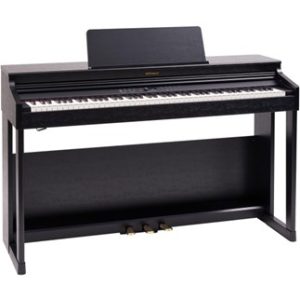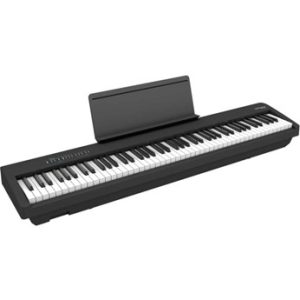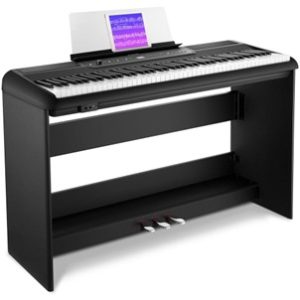In this guide, our aim is to provide you with information that will help you choose the right digital piano for your needs. From sound quality and keyboard feel to additional features such as multiple instrument sounds and recording capabilities, we will try to cover the essential aspects you should consider before making your final decision.
Feel free to navigate through the various sections of this article on the left side of this page and explore the features and options available in the world of digital pianos.
Sound
Digital pianos have been around for decades, and many of the early models were equipped with sounds labeled as “piano.” However, most failed to reproduce the real sound of a piano and could not be considered serious alternatives to the actual instrument. The key, in a way, to the digital revolution of the piano lies in the technology known as “sampling.” This involves recording the sound of a real piano being played, sometimes note by note and at various dynamic levels, and then reproducing it when the keys of the keyboard are pressed. The quality of the samples used varies significantly, and the cost of a digital piano is closely related to the investment made in creating the original sound. In essence, the principle “you get what you pay for” applies, meaning the more expensive a digital piano is, the better the quality of its sound.

High-quality microphones, preamps, and other recording equipment are used to capture samples in the best digital pianos. The art lies in reproducing the real feel in the sound the moment a key is pressed – the sound must be authentic and consistent, whether played softly or with energy. In the era of sampling, even low-cost digital pianos can sound convincing and play well – often better than real pianos of equivalent price. They usually provide more than one type of piano sound, so you can choose one that suits your preferences – a grand piano with a tail or an upright piano. Whatever your preference, sampling technology has made it possible for most of us to have a piano with good sound that can be conveniently placed even in a small room.
When purchasing an instrument, regardless of the type, it is always important to know what sound you are looking for. As we have seen, there is a direct relationship between sound quality and price in digital pianos. Today, however, it is a fact that even with digital pianos at a more affordable price, they are suitable for any beginner who wants to take the first steps in playing the piano.
One of the most important things to consider when buying a digital piano is the “piano sound” it simulates. Various manufacturers use different methods to create an authentic acoustic sound. The most common method is sampling, i.e., recording each key when pressed on a piano. Each sound has its own characteristics. In top-quality models, background sounds and resonance are recorded separately to better convey the character of a piano. Another option is to combine/modify this sampling technique with sound synthesis.
Beyond the high-quality simulation of a piano, there are usually other “sounds” and options. Sounds like the organ, harpsichord, vibraphone, or violins are usually included as standard in most models.
The Cabinet
There are two basic choices that shape the appearance of the digital piano – do you want something lightweight and portable, possibly made of plastic or metal – in which case, the best choice for you would be a Stage Piano, or do you want a nice piano with a wooden finish and a wooden base? The good news is that regardless of your choice, almost all digital pianos are lighter than traditional pianos, making them easier to transport.

For Live Performances:
Pianists playing in live performances might opt for a truly portable model like a Stage Piano. Here, the primary concern is the durability of the carrying case and the arrangement of controls. A good carrying case is always essential.
For Home Use or Permanent Placement:
If the piano is for home use or another space where it will be placed permanently, then appearance becomes perhaps a more significant consideration. There are many models that are excellent replacements for real pianos in terms of appearance, with beautiful wooden finishes in various colors. The significant advantage is that there are plenty of options – digital pianos come in all shapes and sizes, so you can choose a design that fits your space.
The Keyboard
The keyboard of a digital piano is crucial for a realistic and comfortable playing experience. Significant progress has been made in this direction to enhance the feel of digital pianos. Today, there are models with 88 weighted keys or more, categorized with different weights similar to a traditional piano. The reason for different weights is that in a traditional piano, the strings in higher octaves are thinner and shorter, while they become longer and thicker in lower octaves, requiring an increase in the weight on the hammers that strike the piano strings. This means that keys with different weights are necessary to make the digital piano keyboard more realistic in playing.
The simulation of the key release point is also used by many manufacturers as an additional step to make the keyboard even more realistic. The release point is where the piano hammer returns after striking the string to its initial position. This system exists in all traditional pianos, and you can feel it by pressing a key slowly without producing sound. Just before the key reaches its lowest point, you can feel the release point.
Manufacturers often differentiate in the quality and technical structure of their keyboards. For this reason, some manufacturers make a great effort to closely approach a traditional piano in the digital form. For example, they may use wooden keys, even in their mid-range digital pianos. A wooden key has a different playing behavior than a plastic one due to its weight and its pivot point.
In recent years, various key surfaces have been used. Some manufacturers add a layer of synthetic or ivory-textured imitation to allow fingers to have a better grip on the keys. The material used has an absorbent effect, preventing fingers from slipping even after extended play. Additionally, keyboards with this coating are easier to clean.
Finally, in traditional pianos, a complex mechanism ensures that hammers return quickly to their initial position, allowing rapid repetition of a note and better control during playing. For the same reason, digital pianos use two or more sensors so that even the smallest details are accurately recorded and reproduced during playing.

Additional Features
Some digital pianos offer many functions beyond a weighted keyboard and various sounds. Some have different styles and rhythms to accompany your musical creations with a whole orchestra. Other features include:
- Recording:
- A function could be the internal recording of the pieces you play, which can be processed with various options on a computer/tablet, etc.
- Microphone Connection:
- A microphone input enables the connection of a microphone, which can be controlled through the digital piano. With the press of a button, the player/singer can sing while simultaneously playing the piano.
- Display Screen:
- Today, electric pianos come with a screen that allows easy navigation through functions and menus. The simple and readable display ensures smooth operation while playing the piano.
- Connectivity:
- All the connections that a digital piano has aim at multifunctionality on various levels. With the help of MIDI and USB, an electric piano can be connected to a computer with unlimited additional possibilities.
- The connectivity that a modern electric piano should have includes:
- USB/MIDI port for connection to a computer.
- Headphone output for silent practice.
- Input for sustain pedal.
Accessories for Digital Pianos
Accessories for Digital Pianos
- Pedal:
- Your piano may have built-in pedals on its base or sockets for connecting separate pedals. If you want a sustain pedal, make sure the instrument has at least one input for a pedal.
- Stands:
- If you are a musician performing in concerts, you might need a separate stand for the stage piano. Invest carefully and choose a stable stand with double legs. Ensure that your stand is adjustable, durable, and very stable.
- Piano Bench:
- A wooden piano bench is ideal for home use, while a portable bench is recommended for mobility. Good height adjustment is key—make sure you can adjust the seat height to match the piano.
Our Selections
- Explore all the available options we have for you. (Active link to Electric Pianos category)
Conclusion
Choosing a digital piano is now easier than ever, with more affordable prices and a wide variety available. Consider the sound, the feel of the keys, and the appearance, as well as the ease of transportation. While no classical piano can ever be exactly the same as another, digital pianos offer consistency, flexibility, and more sound options. Moreover, you can have something that sounds very similar to a classical piano in your living room at a much lower cost and without the ongoing expenses, as a digital piano never needs tuning! So, proceed with open eyes and ears, and find the digital piano that offers you the sound you want at a price that best fits your needs – thank you for reading!



